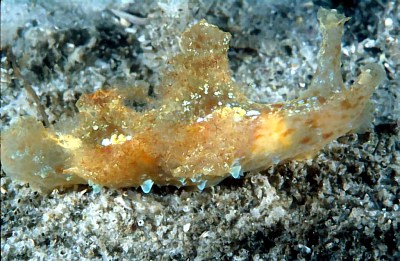
Notobryon wardi
Odhner, 1936
Order: NUDIBRANCHIA
Suborder: DENDRONOTINA
Family: Scyllaeidae
DISTRIBUTION
Indo-West Pacific (Japan, Queensland, South Africa).
PHOTO
Fly Point, Port Stephens, New South Wales, Australia. November 1999. PHOTO: Ron Greer.
NOTE: At present I am putting all photos which seem to represent species of Notobryon on this page. It is possible that more than one species is represented here.
Notobryon wardi was first described from Queensland, Australia. Baba (1937) described two more species from Japan, one of which (N. bijecurum}, he said differed from N. wardi mainly in having unequal sized mantle lobes, the anterior being larger than the posterior pair. The significance of this feature is unknown as Baba had only a single specimen, and the only study of multiple specimens (Thompson & Brown, 1981), doesn't address this point. Notobryon is closely related to Scyllaea pelagica and Crosslandia viridis. It differs from both in lacking a median tooth in the radula and from Crosslandia, in having a medio-dorsal posterior crest, which is absent in Corosslandia. Both Scyllaea and Notobryon have a medio-dorsal posterior crest, and both use it when disturbed as a 'paddle', to swim by vigorously waving it from side to side. Like Scyllaea, it has dendritic gill-like processes on the inside of the mantle lobes, especially in larger specimens.
Notobryon feeds on hydroids.
References:
• Baba,K (1937) Two new species of the nudibranchiate genus Notobryon from Sagami Bay, Japan. Venus, The Japanese Journal of Malacology, 7(4, November): 165-170.
• Thompson, T.E. & Brown, G.H. (1981) Biology and relationships of the nudibranch mollusc Notobryon wardi in South Africa, with a review of the Scyllaeidae. Journal of Zoology 194(4): 437-444.
Rudman, W.B., 2000 (May 29) Notobryon wardi Odhner, 1936. [In] Sea Slug Forum. Australian Museum, Sydney. Available from http://www.seaslugforum.net/find/notoward
Related messages
Re: Scyllaea pelagica? from sthn Queensland
October 16, 2008
From: Gary Cobb
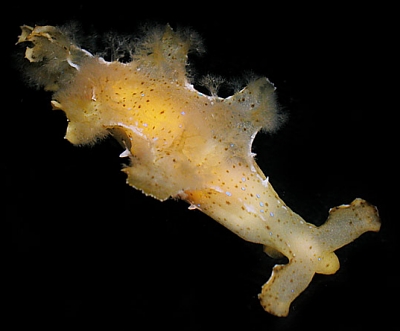
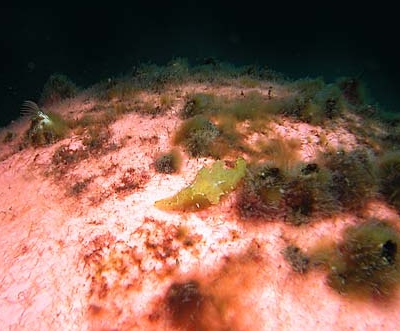
Concerning message #14049:
Hi Bill and everyone!
I thought you might like to add an addition to your list from southern Queensland. This animal was found after a dive on the HMAS Brisbane, during our safety stop I noticed this critter on the mooring buoy just before we were to ascend!! SCORE!
Locality: Mooloolaba, Sunshine Coast, 5 m, Queensland, Australia, Pacific Ocean, 27 January 2006, Subtidal. Length: 50 mm. Photographer: Gary Cobb.
Cheers
Gary
gary@nudibranch.com.au
Cobb, G.C., 2008 (Oct 16) Re: Scyllaea pelagica? from sthn Queensland. [Message in] Sea Slug Forum. Australian Museum, Sydney. Available from http://www.seaslugforum.net/find/21939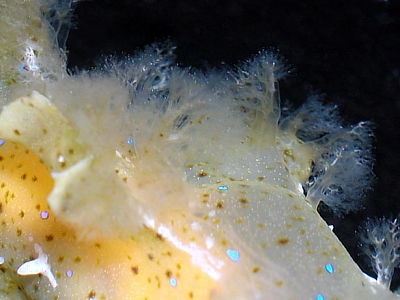
Dear Gary,
Every time I see one of these fascinating animals I get more confused trying to identify them to the genus level. There are really no external features to separate Scyllaea and Notobryon. Internally, Scyllaea differs in having a central tooth in the radula, while Notobryon does not. My feeling is that this is probably Notobryon wardi which was described from Queensland, Australia. It doesn't help that it was described from preserved animals so we have no idea of the colour or living shape of the original specimens.
At present Scyllaea, as represented by S. pelagica, can be identified externally by the dark brown band along the side of the body, just below the mantle edge. On those grounds I think I would rather identify your animal as Notobryon. Of course the only way to be sure is to look at its radula. Whatever it is, it is a wonderful find. One of the reasons we have trouble with this group is that Scyllaea pelagica appears to be the only species which is regularly encountered. This is because it lives on floating weeds and often washes ashore after storms. If it were not for the radular difference, I would suggest we consider Scyllaea and Notobryon to be one genus, but until we have many more specimens - preferably with photographs or drawings of them alive - we won't be able to get past the impasse created by Odhner's study of preserved animals many years ago.
-
Odhner, N.H. (1936) Nudibranchia Dendronotacea - A revision of the system. Mémoires du Musee Royal d'Histoire Naturelle de Belgique, series 2, fasc. 3, 1057-1128. (Pl. 1)
Best wishes,
Bill Rudman
Notobryon ? from nthn Mariana Islands
April 17, 2008
From: Takao Urasawa
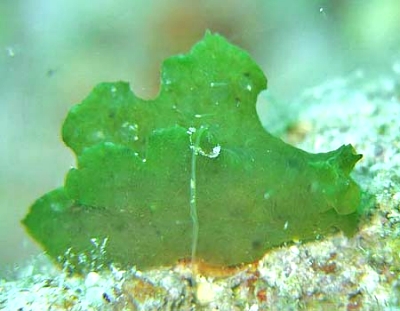
Concerning message #20102:
Dear Dr.Bill,
Here are three pictures which we think are of Crosslandia viridis.
This animal doesn't move at all.
Locality: LauLau Beach, 6 m, Saipan, Northern Mariana Islands, Pacific Ocean, 15 February 2008, on the dead coral. Length: 7 mm. Photographer: Takao Urasawa.
Best regards,
Ura
ds-with@isletwind.com
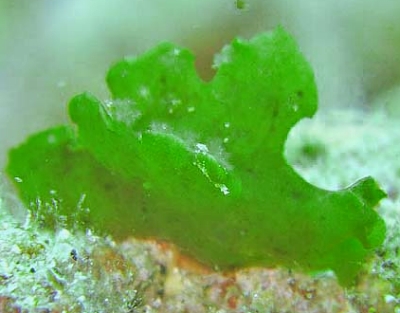
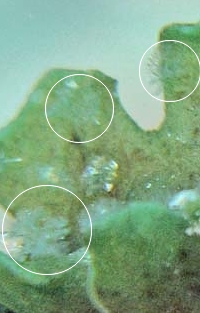
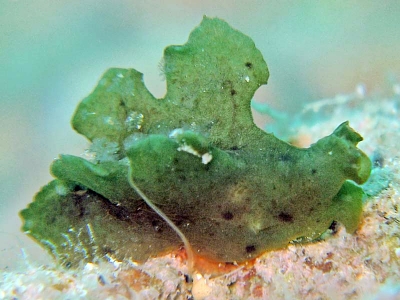
Dear Ura,
Thanks for these photos. I am afraid the Scyllaeidae is in a confiused state at the moment and we will only be able to solve it when more material is available. I suspect your animal is a species of Notobryon but we would need to look at the radula to be sure.
I have included a small close-up to show the bushy secondary gills on the inside of the parapodia.
Best wishes,
Bill Rudman
Notobryon wardi - caprellid symbiosis?
July 13, 2007
From: Guido Zsilavecz
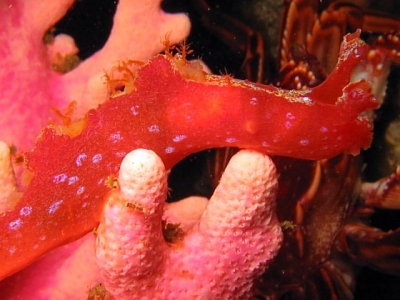
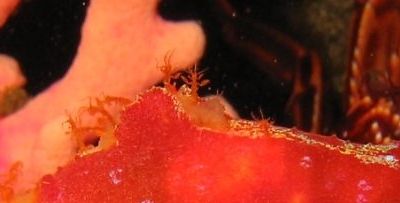
Good day Bill!
While photographing Notobryon wardi I concentrated on its odd gills with an attempt to finally see what they really look like. On viewing the images later I noticed a group of caprellid amphipods hitching a ride there. Thinking it was a once-off scenario, I checked my other photos and found a number of them showing caprellids as well, and on subsequent dives found the same again. I can imagine that the caprellids are happy to have a mobile perch, but could the N. wardi get something out of it? Is this a known phenomena?
Locality: Oudekraal, Cape Town, 10m, South Africa, Atlantic, 16 December 2006, Subtidal. Length: 5cm. Photographer: Guido Zsilavecz.
The two images are of different animals.
Thanks,
Guido Zsilavecz
guido@surg.co.za
Zsilavecz, G., 2007 (Jul 13) Notobryon wardi - caprellid symbiosis?. [Message in] Sea Slug Forum. Australian Museum, Sydney. Available from http://www.seaslugforum.net/find/19058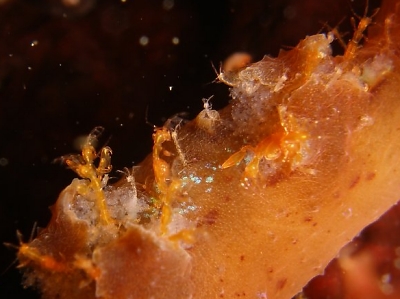
Dear Guido,
What an interesting observation. I can't say I have heard of such an observation before but perhaps there is something in the amphipod literature - the natural sciences haven't been good at cross-referencing. What I have observed often is that hydroid-feeding nudibranchs tend to compete with caprellids on hydroid colonies. You seldom find both aeolids and caprellids together on the same colonies. I certainly don't bother looking for aeolids on hydroid colonies with caprellids. I always thought that the caprellids were eating the hydroids but I came across an interesting paper (Caine, 1998) which showed that caprellids are herbivores feeding on the algal film, diatoms etc, which cover the substrate. Caine found that the caprellid amphipod Paracaprella tenuis Mayer has a mutualistic relationship with the hydrozoan Bougainvillia rugosa Clark, and adult male caprellids would aggressively displace the nudibranch Tenellia pallida (Alder and Hancock) when itvwas attempting to eat the hydroid. He reports that when the nudibranch crawls within a body-length of the amphipod it is aggressively displaced by the caprellid. This means that hydroid polyps around the caprellid are protected from predation, and continued attacks often mean that the nudibranchs leave the whole colony. Caine hypothesises that through this behaviour the caprellid receives a suitable substratum and food in the form of attached diatoms and entrapped detritus.
I guess its difficult to compare the relationship of Notobryon and caprellids to that of Tenellia, which is similar in size to the caprellids. Notobryon is a hydroid feeder, but as caprellids are certainly found in other places than on hydroid colonies, its not that they are being advantaged by a free ride to the next hydroid colony. Perhaps being on a 'big' nudibranch affords some protection. I don't know, but I wonder if Notobryon feels itchy?. This relationship certainly deserves a serious study.
-
Caine, E.A. (1998) First Case of Caprellid Amphipod-Hydrozoan Mutualism. Journal of Crustacean Biology, 18(2): 317-320
Best wishes
Bill Rudman
Radula of Notobryon wardi
September 14, 2002
From: Bill Rudman
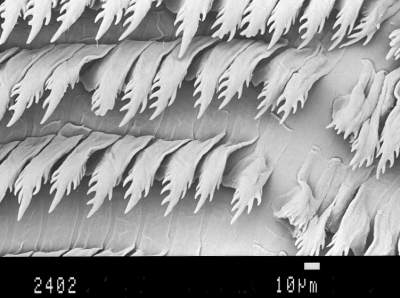
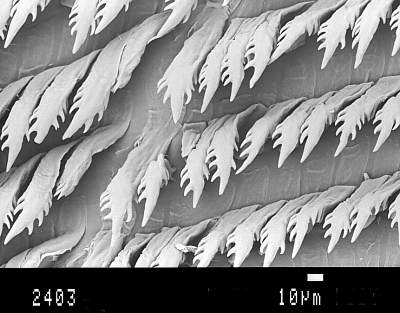
Here are some SEM photos of the radula of Notobryon wardi.
PHOTOS: Hong Kong, 11 April 1983. AM C139151. Both photos showing the central region of the radular ribbon. Note the absence of a central tooth. [there are some mishapen first lateral teeth]. Photos: Geoff Avern.
Notobryon wardi lacks a central tooth. Scyllaea pelagica, like Crosslandia viridis, has a central radular tooth, closely flanked on each side by lateral teeth.
Bill Rudman
Rudman, W.B., 2002 (Sep 14) Radula of Notobryon wardi. [Message in] Sea Slug Forum. Australian Museum, Sydney. Available from http://www.seaslugforum.net/find/7938Notobryon wardi? from Mexico
September 14, 2002
From: Ali Hermosillo
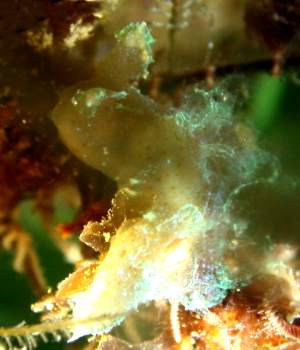
Dear Dr. Rudman,
I have found more specimens of the species we are thinking might be Notobryon wardi in previous messages. I have seen several animals, all during night dives and probably eating or hanging around the same hydroid Lytocarpus sp. where you can find Lomanotus vermiformis.
This is the first in situ picture I send you of Notobryon cf. wardi and I have been pretty surprised to see so many of them on this particular site at night, still, you can appreciate how cryptic a species it is.
Data: 52 feet deep, 12 mm long, Los Arcos, Bahia de Banderas, Pacific Coast of Mexico. August 17, 2002
Please note on the lower right photo that there is a tiny Notobryon on the Lytocarpus.
Ali
gueri25@hotmail.com
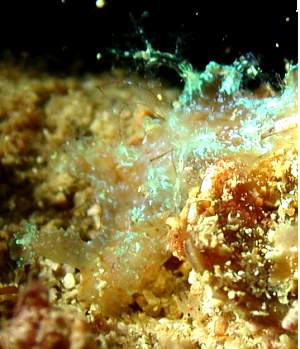
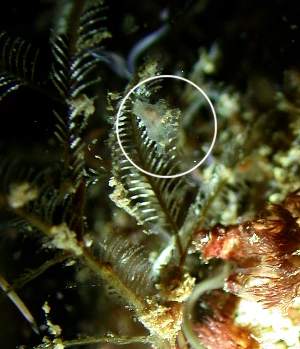
Thanks Ali,
We often find that these hydroid feeders often occur in large numbers or scattered in ones or twos. I think it probably reflects the haphazard nature of their life history. If by chance a 'swarm' of veliger larvae stay together in the plankton then they are likely to metamorphose and settle on the same colony of the animal they feed on. If on the otherhand they spend their time in the plankton alone, then they are most likely to settle out of the plankton alone to spend a solitary life on their food. It is possible that other veligers may later settle on the same colony but I suspect good luck stories aren't that common in nature.
Best wishes,
Bill Rudman
Notobryon wardi? from west Mexico
June 29, 2002
From: Alicia Hermosillo
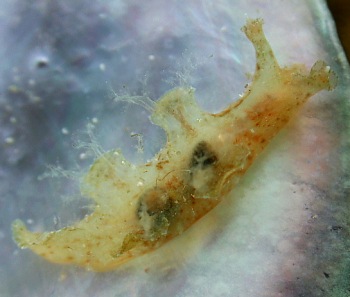
Dear Dr. Rudman,
I found another specimen of the same animal you identified as possibly being Notobryon wardi. I think these pictures might be better. Any thoughts??
Picture data: 22 feet deep, 17mm long, Faro Bucerias, Michoacan, Pacific Coast of Mexico.
Alicia Hermosillo
gueri25@hotmail.com
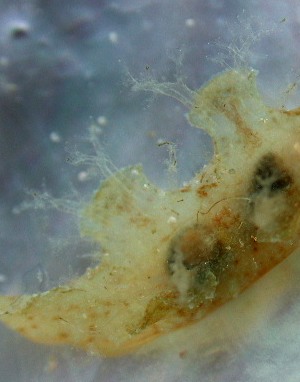
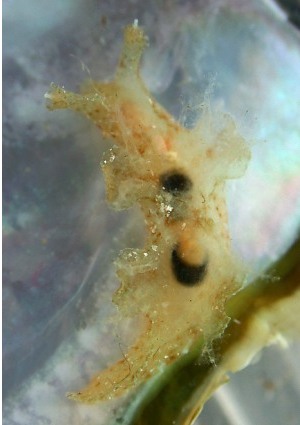
Dear Ali,
Yes this seems to be Notobryon. In this genus there are a few large finely branching gills, while in Scyllaea the gills are much shorter and more numerous, I don't think we know enough about the genus to say with any certainty whether there is one widepread species or a number of different species.
Best wishes,
Bill Rudman
Notobryon from Hong Kong
May 23, 2002
From: Bernard Picton
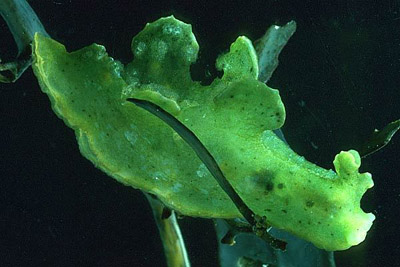
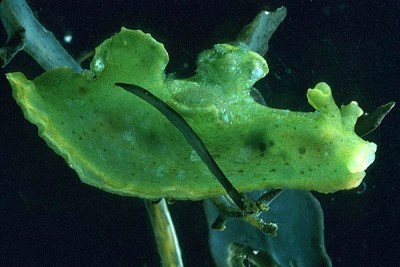
Hi Bill,
Seeing the pictures of Notobryon appearing on the Forum I wonder if
this animal from Hong Kong, is a different species? It seems to be quite different in colour and shape to Notobryon wardi. Here are two pictures of the same animal.
BEPHK97 - 11 Apr 1983 - NW Kong Chau, Mirs Bay, Hong Kong - 5-10m
Bernard
bernard.picton.um@nics.gov.uk
Picton, B. , 2002 (May 23) Notobryon from Hong Kong. [Message in] Sea Slug Forum. Australian Museum, Sydney. Available from http://www.seaslugforum.net/find/5948Thanks Bernard,
Alicia's messages about scyllaeids from the east Pacific suggest that some of these animals may have green and brown colour forms or phases. I suspect we need quite a few more specimens to be collected before sensible comparative work can be done,
Best wishes,
Bill Rudman
Scyllaeidae from Bahia de Banderas, (2)
May 18, 2002
From: Alicia Hermosillo
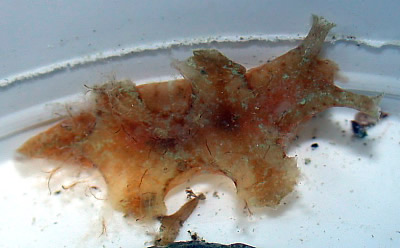
Dear Bill,
Here is another of the scyllaeids which are causing me problems.
This specimen was observed at Playa Mismaloya, Bahia de Banderas, Pacific coast of Mexico, 26 feet deep on a rock that was covered with the alga you see in the picture. It was 20mm long with two other specimens (35 and 25mm) last April, 2002.
If I had to guess, I would say this animal is Scyllaea pelagica and the others in message 1 and message 2 are Crosslandia daedali but this one could also be a variation of C. daedali. What is your opinion?
Thanks a lot, I am really confused.
Ali
gueri25@hotmail.com
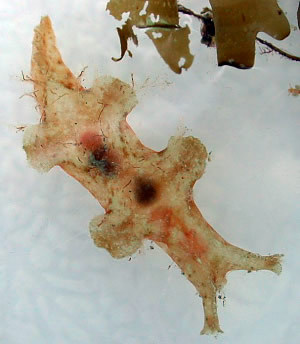
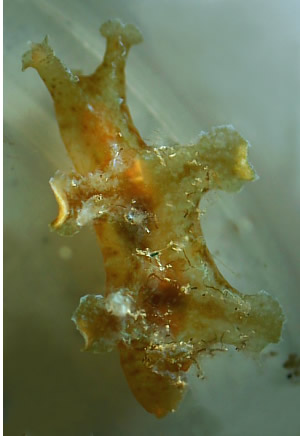
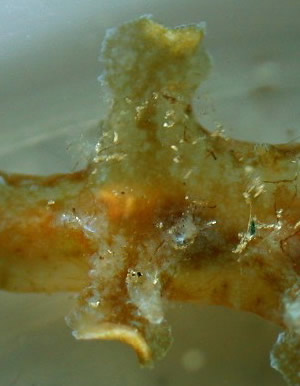
Dear Ali,
It's quite normal to be confused with these scyllaeids. They all look very similar externally. The radular morphology is quite a good character, at least at the genus level, but we have little knowledge of colour variation, and just how many species there are at present.
I am pretty sure this is a species of Notobryon. With some hesitation I will identify it with the Indo-West Pacific species Notobryon wardi. One point of interest is illustrated in the close-up of one of your photos alongside. See the branching ducts in the dorsal lobes. They look as though they are branches of the digestive gland, but in this family the digestive gland forms 3 distinct unbranched lobes. These ducts are in fact branches of the kidney.
I think this is the first record of this genus from the eastern Pacific.
Best wishes,
Bill Rudman
Notobryon wardi from the Philippines
August 9, 2001
From: Erwin Köhler
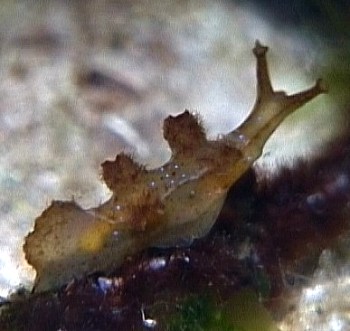
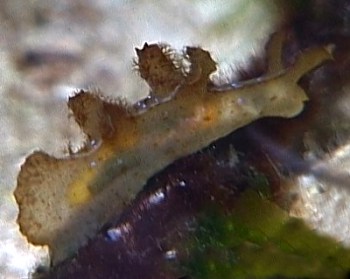
Dear Bill,
Here is another one from the Philippines by Peter Schmutz
EMAIL: peterschmutz@cs.com.
Other data were not recorded. It is a shot from a video, so the quality is pretty poor. Can you help with an ID?
Erwin
Erwin@medslugs.de
Köhler, E., 2001 (Aug 9) Notobryon wardi from the Philippines. [Message in] Sea Slug Forum. Australian Museum, Sydney. Available from http://www.seaslugforum.net/find/4900Dear Erwin,
This is Notobryon wardi, which is a close relative of Scyllaea pelagica and Crosslandia viridis.
Best wishes,
Bill Rudman.
Notobryon bijercurum or bijecurum?
July 24, 2000
From: Pauline Fiene-Severns
Dear Dr. Rudman:
Can you confirm the spelling of Notobryon bijercurum Baba 1937. It is spelled bijecurum on your page, but elsewhere I have seen it as bijercurum.
Thank you,
Pauline Fiene-Severns
severns@mauigateway.com
Fiene-Severns, P., 2000 (Jul 24) Notobryon bijercurum or bijecurum?. [Message in] Sea Slug Forum. Australian Museum, Sydney. Available from http://www.seaslugforum.net/find/2771Dear Pauline,
I could say that when you come to the Forum you get the correct story, but having been guilty of typographical errors myself, I won't tempt fate. In this case, I am glad to say my spelling, (bijecurum), is how it is spelt in the original publication, which I cite at the top of this page.
I am curious about your interest. Have you found specimens that fit Baba's description? Any news, information or photos would be welcome,
Best wishes,
Bill Rudman.
Notobryon wardi at Fly Point, Port Stephens
May 30, 2000
From: Ron Greer

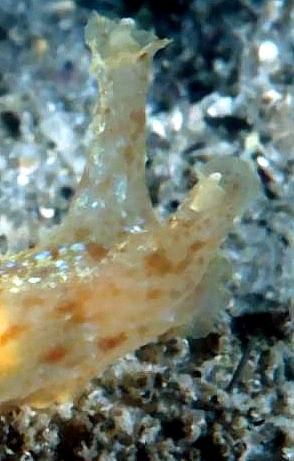
Dear Bill,
Late last year I sent you a couple of images for ID that you confirmed as Petalifera ramosa. That week of diving [November 1999] was the most prolific I had seen in 10 years at Fly Point [Port Stephens, New South Wales, Australia]. Of the 25+ species I saw were 5 that I have been unable to ID. Here is one of them. I hope you can ID for me.
Regards,
Ron.
diveimage@i-o.net.au
Greer, R., 2000 (May 30) Notobryon wardi at Fly Point, Port Stephens. [Message in] Sea Slug Forum. Australian Museum, Sydney. Available from http://www.seaslugforum.net/find/2411Dear Ron,
This is quite an interesting find. It is related to the pelagic species Scyllaea pelagica which Anne Dupont has sent such great photos from Florida. It does not seem to be that common, although Thompson & Brown (1981) reported that it was commonly under intertidal boulders in False bay, South Africa. We don't know much about its biology other than it feeds on hydroids.
As we can see in the enlarged photo of the head, the rhinophore stalks are relatively huge, the small rhinophores nestling at the tip.
Best wishes,
Bill Rudman.
